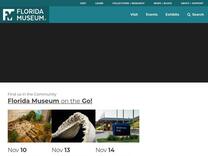Jonathan Bloch appointed chair of department of natural history – Research News https://www.floridamuseum.ufl.edu/science/jonathan-bloch-appointed-chair/
Jonathan Bloch has been appointed chair of the Florida Museum of Natural History department of natural history. In the new role, Bloch plans to work with the museum’s team of faculty curators, collections managers, postdoctoral researchers and students to continue documenting the world’s biodiver
research and education.� The department has 30 faculty who manage about $65 million

